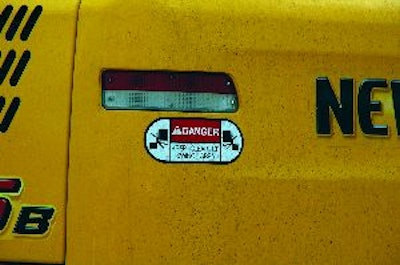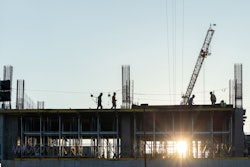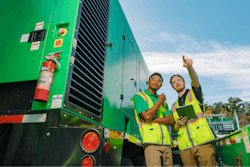
Each year, there are thousands of injuries and triple-digit numbers of fatal accidents related to machine and equipment operation. A lot of these accidents involve the operator, but over half involve people on the ground - spotters, co-workers, laborers, shovel hands, passers-by and sidewalk superintendents who get too close. And because of the forces and physics involved, these are usually not first-aid injuries; there is often an ambulance and sometimes a coroner called to the jobsite.
A review of OSHA and MSHA Fatality Alerts & Bulletins reveals that practically all of these accidents are preventable. Safety awareness and caution when performing the most routine operation are characteristics of a good operator. Yet, if you take a few moments to read a few of the fatality reports at the above web sites, you will find operators with decades of experience on the list.
Before we take a look at the list of Top 10 causes of jobsite accidents and how to avoid them, we need to offer some reminders about operator training. This is usually a topic where the owner says, "Oh, my guy has been running that machine for X amount of years; he knows all there is to know." And that may very well be the case. It does not, however, fulfill your obligation under OSHA, MSHA or the rules of civil liability known as Tort Law.
All operators must have identifiable and verifiable training on the machine or equipment. Most equipment dealers will provide this training as part of their customer service, and you need to take advantage of it. We're not talking about a semester credit course, but there is a Student Workbook, a video and usually a quiz. There is also a practical section where the student will operate the machine to confirm understanding of key controls and functions. A Certificate of Completion will then be issued.
The larger or more complex the machine, the more in-depth the training should be. Remind me, how much did that rig cost? And you're going to try to skimp on the training? Better keep reading.
1. Getting on and off equipment
Getting on and off the machine is the No. 1 cause of injury to equipment operators, forklift drivers and truck drivers, any one of whom will readily share their "learning episode." It happens a lot.
First, check your gloves and boots. Clean the mud off before climbing, and use "high grip" gloves for a secure hand hold. Next, use a three-point stance going and coming. Use large size hand and foot holds. Securely engage the entire hand and foot, avoiding a toe-hold or finger-hold grip. Use a step ladder for access when no hand or foot holds are provided. Avoid carrying objects while climbing.
If the machine needs additional hand holds or steps installed, do it. Operators come in different sizes. Make it as easy and safe as possible to ascend/descend. Avoid the need to stretch by putting the grab rails where they're easy to securely reach.
When exiting the machine, correct practice is to lower yourself in a controlled manner - never jump!
- Construction Safety Tips for Slips, Trips and Falls at Work
- Don't Miss a Step with Jobsite Ladder Safety
2. Loading/unloading equipment
Even on level ground, there is a risk of machine roll-over during loading or unloading. Make sure you are centered on the ramps and stay straight. Allow enough room to maneuver the trailer and machine, which is sometimes difficult on tightly compressed jobsites.
Use a spotter for guidance. Make sure the machine clears the ramps before turning. Keep people away from the sides of the machine during loading/unloading.
Check the trailer deck, clearances and stability. Review your lock-out/tag-out plan to be sure the machine is at "Zero Energy State" when stowed.
Use proper tie-down procedures. If using compression chain binders, use caution when opening the handle. The load may shift just enough to add tension to the chain and the handle may spring open. Use safety tie wires or switch to ratchet binders.
3. People crowding the work area
Ask any backhoe operator what their biggest headache is and they will tell you without hesitation - people on the ground crowding the machine. People love to stand at the edge of the hole and watch the dirt being moved. There is usually no reason for them to be there, just force of habit. But why create an exposure to injury when none needs to exist?
People on the ground must stay well away from the machine operating area. Review this important point at safety meetings. Foremen need to enforce this, not the operator.
When ready to start work, use the horn to warn people to stay back; stop the machine if needed; and always check your back before backing up the machine.
4. Machine swing radius
Swing radius accidents are common. How do you think all those scrape marks got on that counterweight? Unfortunately, they are also usually fatal when people are involved.
Thus, it's important to rope off the swing radius around the machine or otherwise secure it. Allow no spectators; use a spotter to keep all people clear.
5. Operation on slopes
Caution is always required when operating on slopes. You might make it up the slope with a load, but coming down is another story! Know the limits of the machine, allow for surface conditions and don't push it.
6. Overhead/buried obstructions
Be aware of overhead obstructions and underground utilities, including electrical lines, water, sewer, gas, telecom, etc.
Definitively mark or warn of overhead lines or low clearances. When digging, call Dig Safe or whichever agency has jurisdiction. Continue to use caution even after underground lines are marked, since errors in marking are common. Be prepared to hand dig when it's getting close.
Use sawhorses, signs, barrier tapes, etc., to indicate obstructions. Take no chances.
7. Backing
Reverse motion on anything in this industry is fraught with peril. Backup alarms on construction machinery are basically cosmetic devices in terms of assuring a clear backside. As such, operators need to positively assure that no one or nothing is behind them. This is achieved by getting out and looking.
Always check the machine perimeter before moving. When vision is impaired, have a spotter (in high-visibility apparel) guide you.
Use wide angle mirrors. The new generation of machines is fitted with best viewable surface mirrors. Keep them clean and adjusted.
Use rear-mounted cameras and/or rear-mounted presence-sensing alarms. Presence-sensing alarms are becoming more reliable as technology improves. The equipment industry recognizes the urgency of the problem and will find technical solutions to address chronic people behavior problems.
8. Machine upset
If a piece of equipment starts to tip, your seat belt becomes your lifeline. Yet, the list of excuses for failure to use seat belts or harnesses is amazingly long. Most operators would make great fiction writers with the excuses they can come up with. If it weren't so grim, we should offer to add their reasons to their obituary.
Always use a seat belt. A professional operator will not have to be reminded of this bed-rock rule. Wear the belt even with the cab door closed. It decreases how much you will bounce around in the cab during normal operations, and may help you control the machine in a borderline upset situation.
In addition, operators need to understand the machine's stability characteristics on all surface types and conditions. Check to see if the equipment manufacturer or dealer offers an instructional video.
9. Instability or loss of load
Moving dirt or bulk materials is fairly straightforward. It becomes more complex when you try to use the hoe as a crane, or otherwise become creative in finding new applications. The best pipe layers in the world might only be "fair" when it comes to rigging. All rigging attachments for lifting must be engineered for safety. Be sure to use:
- oversized fittings
- positive locking attachments
- safety latches on all hooks
- correct lifting angles on chains or cable bridles
- properly inspected nylon slings
- abrasion and cut protection on sharp edges and masonry
- spreader beams to provide correct lifting geometry
Keep all people well clear of a load being lifted or handled. Either get the guys out of the trench, or send them to a safe distance when the pipe is being placed. Never lift a load over people.
A lot of serious accidents also occur when trying to use one machine to do multiple functions. Rough-terrain forklifts, skid steers and similar multi-use machines are versatile, but are often pushed beyond their limits for expediency. Operators need to understand that there are limitations that must be observed and safety is primary.
10. Lock-out/Tag-out
Most mechanics will tell you a horror story or two that illustrates why OSHA made the lock-out/tag-out (LOTO) rule. Any raised load (or object, such as the bucket or attachment) is subject to LOTO provisions.
All pinch points on a machine must be identified and protected (guarded) when possible. The minimum warning is a pictorial decal advising of the hazard. If a dump body has a safety "crutch," make sure it is functional and used.
Refueling, service personnel and mechanics need to use positive means to assure their safety while servicing or working on the machine, i.e., wheel chocks, steering wheel covers with LOTO Warning imprint and LOTO locks, tags and hardware configured to the machine.
Review manufacturer directions for safety in all cases, even if this is the fifth generation of machine you bought from the same manufacturer. There are illustrations and directions in all manuals to point out safety features, do's and don'ts, good practices/bad practices, efficiency measures, etc.
Safety focus
The equipment and machinery produced today are the safest and most reliable ever made. To get the most out of these tools and ensure your employees' safety, a comprehensive safety program should not only be in place on all your jobs, it should be relevant, timely, frequently referenced and backed up by top management. Keep your operators and ground crews informed of the hazards they face (i.e., by reading the machine manual), keep them motivated and aware and recognize their accident-free achievements.



















